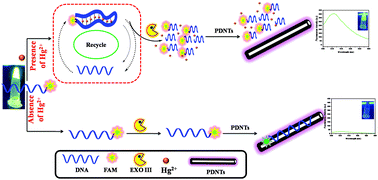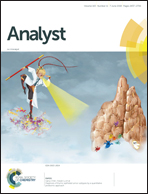Polydopamine nanotube mediated fluorescent biosensor for Hg(ii) determination through exonuclease III-assisted signal amplification
Abstract
We describe a highly sensitive fluorescence biosensor incorporating polydopamine nanotubes (PDNTs) based on the mechanism of exonuclease III (Exo III) assisted signal amplification for the determination of Hg2+ in aqueous solution. Fluorescent probes of FAM labeled ssDNA (FAM-ssDNA) adsorbed on the PDNTs act as an efficient quencher. In the presence of Hg2+, the FAM-ssDNA can bind to Hg2+ to form double stranded DNA (dsDNA) via the formation of T–Hg2+–T base pairs. Then, the dsDNA was removed from the surface of the PDNTs to restore the fluorescence. The release of the dsDNA was triggered by Exo III digestion. At the same time, the liberated Hg2+ mediates a new cycle of digestion. This assay is ultrasensitive for the selective recognition of Hg2+, and a detection limit as low as 10 pM was achieved. In addition, the fluorescent biosensing system also displays remarkable specificity to Hg2+ in the presence of other possible competing ions. This approach was applied to the determination of Hg2+ in real water samples with good recovery and high efficiency for practical analysis.



 Please wait while we load your content...
Please wait while we load your content...